|
|
|
| |
All images link to larger
copies which will open in a new window/tab
|
|
|
Australia is the home of the largest number
of side-wheel paddle driven ships in the world - by a considerable
margin. There are between 100 and 150 paddle vessels still in
existence. Many were built in the 19th century but some are quite
recent. Many have their existing engines whilst some have
replacement diesels fitted. Others are new, built around original
engines whilst many others have had engines removed completely for
use as houseboats. A further large number of derelict vessels
remain, usually sunk alongside the riverbanks.
Murray River Paddlesteamer Images and Notes by Ian
Greig
The greatest concentration of Australian paddle vessels is to be found on
the Murray River in Australia which, until the advent of railways, was one
of the most important inland transport links in the country, and for much of
its course forms the border between the states of Victoria and New South
Wales. Today it is a significant tourist destination, and several former
river ports can boast a preserved paddler amongst their attractions. Echuca
stands out for the sheer number now based there; indeed it has the largest
collection of paddle steamers in Australia. At the beginning of 2011 I
finally achieved an ambition that had been in abeyance for over 30 years and
visited Australia. The highlight was undoubtedly being at the Sydney Cricket
Ground to see England win the Ashes, but amongst other tremendous
experiences was spending three days in Echuca to see and travel on the
steamers.
The town was founded at the point where a major tributary, the Campaspe,
joins the Murray, and in the local aboriginal language (Koori) the name
Echuca means 'meeting of the waters'. It is about 120 miles north of
Melbourne, the capital of Victoria and an important sea port, to which it is
the closest point on the river. The first settlement was in 1850, when a
former convict, Henry Hopwood, established a ferry and then in 1853 built a
hotel. There is a 'twin' town, Moama, on the opposite (New South Wales)
bank, but the main port facilities were always at Echuca.
The need for efficient communication with Melbourne was recognised early,
and in 1864 the Victoria Railways built a line from Bendigo to Echuca. From
then on the river steamers brought the produce of the Murray-Darling Basin
(principally wool and timber) to the railhead at Echuca, and by the 1870s it
had become the country's largest inland port, from which goods left for
destinations within Australia and to be exported worldwide from Melbourne. A
large rail-connected wharf was built from the local red gum timber, and this
continued to be extended until the 1880s reaching a maximum length of 363
yards (332 metres). Echuca/Moama was also the main centre for boat building
on the river, and in the 1870s there were seven sawmills in the area.
A depression in the 1890s hit the trade badly. The subsequent extension of
the railway system, and later road transport, inevitably took trade away
from the river. By the Second World War much of the wharf was out of use,
and over three-quarters of it was demolished and taken to Melbourne for use
as firewood! The responsibility for the remaining 82½ yards (75.5m) was
taken over by the Borough of Echuca from Victoria Railways in 1952. From the
1970s, the old port area of the town has been restored to its 1880s
appearance as a tourist attraction by the Port of Echuca Authority, with the
paddle steamers as the central theme. Today there are two operators running
public cruises and charters: the Port Authority themselves own and run the
PS Adelaide,
PS Pevensey and
PS Alexander Arbuthnot,
whilst Murray River Paddlesteamers
(MPS) operate the PS Emmylou,
PS
Canberra and the motor paddler Pride of the Murray. The
cruises normally take about an hour.
My visit coincided with one of the wettest Australian summers for many
years. The Murray was 20 feet above its normal summer level, and the
Campaspe had already breached its banks in places. I was a bit concerned
that sailings might have been suspended, but this actually provided me with
a rare opportunity. On the day of my arrival, the Port Authority were using
one of their two regular vessels,
PS Pevensey, on the public
cruises; the other regular boat is the
PS Alexander Arbuthnot. I
was too late for the last sailing on that day, but I was advised that
because of the state of the river the following day's sailings would be by
PS Adelaide, which is normally only used for special sailings and
charters. The Authority's steamers usually leave from the wharf, but because
the height of the river did not coincide with the available accessible
levels they were sharing the MPS floating jetty just beyond the restored
port centre.
I had two trips on
PS Adelaide, on
consecutive days (18th & 19th January). It is fascinating, and quite
different to European steamers. There are seats, but it certainly
hasn't been over-endowed with facilities for the tourist market. The
vessel is obviously well maintained but it is not a pristine
museum-piece and, as long as it's not crowded, with a bit of
imagination it is not too hard to imagine yourself on a working
boat. I was intrigued to see that it is controlled entirely by the
skipper, with a set of control rods for the engines disappearing
through the roof of the engine area into the bridge above. No
ringing down to the engineer here! The fuel logs are stored under
the foredeck. I don't know how much it consumes, but it didn't
appear to use a great amount; no doubt the fireman's job would be a
lot harder if he had to maintain the full boiler pressure with a
heavy load, instead of the reduced figure used today.
The steering chains connecting the wheel to
the rudder run along the deck, where it is easy to stand on them by
mistake. I don't suppose one person could interfere much with the
steering, but I did wonder what would happen if a whole rugby team
decided it would be a jolly jape to stand on them! There are no
safety rails on the bridge stairs, and a notice makes it clear that
passengers should not climb up there. I was toying with the idea of
seeing if my PSPS membership would act as a passport to the bridge
so I could take a few pictures…at which point my camera batteries
packed up, so I didn't.
After my second trip on
Adelaide I almost
decided not to bother with the other steamer operating, the Murray
River Paddlesteamer Co.'s
PS Emmylou, because although it is steam-powered it is
actually a modern boat, built locally between 1980 and 1982
specifically for the tourist market. I thought, in an overly-purist
way, that it was bound to be an anti-climax after such a historic
vessel as Adelaide.
Fortunately I came to my senses – travelling half way round the
world and not going on it for that reason would have been daft even
by my standards – and am very glad I did. It is a beautifully built
and maintained vessel. The hull form, paddleboxes and superstructure
are in the traditional style but with additional passenger and
catering accommodation, including overnight cabins for longer
cruises. It is approximately 98ft (30m) long and 33ft (10m) wide,
with a steel hull and timber decking. The engine is a 16hp
2-cylinder simple unit built in England by Marshall's of
Gainsborough in 1906, giving a top speed of about 10mph (8.6 knots).
And yes, it is named after the country-and-western singer Emmylou
Harris, a favourite of the owner.
As soon as we were properly under way on an open stretch of river,
there was an announcement over the tannoy inviting anyone who was
interested to visit the bridge. I waited until the initial rush had
died down and then made my way up, where I met the skipper, Peter
Garfield. There is a man who knows his paddle steamers. I explained
I was a PSPS member from the UK, and he immediately asked me what
all the tragic news of the Lincoln Castle was about. He was
actually rather enjoying the high level of the river, because it
gave a better view over the river banks than is often the case. I
was on the bridge for most of the trip, enjoying the company and
conversation of Peter and one of his crew who joined us part way
through. I stayed in the background while we turned at the half-way
point, when I was able to watch the skipper controlling the engines
from the bridge, as on the Adelaide. I left the bridge as we
approached the jetty at the end of the trip, so that I was not a
distraction for the serious work of coming alongside.
The company's other steam vessel is the
PS Canberra. This
was built in South Australia in 1912 as a single-deck steamer for
fishing. It was later converted to carry cargo and in the 1940s was
refitted as an excursion boat with an added upper deck, operating at
Mildura. It has been at Echuca since 1963, and was restored in 2003
at which time the present 2-cylinder Marshall compound engine was
installed. A third vessel
Pride of the
Murray has diesel engines.
There are a number of other privately owned paddle steamers at
Echuca. PS Etona
was built in 1898 as a Church of England missionary steamer with the
aid of funding from Eton College (hence the name and the cross over
the bridge). Made redundant when churches were built in the river
towns, it became a fishing vessel in 1912. It was later bought and
moved to Echuca, where restoration commenced in 1962. It still has
its original engines.
In theory, PS Hero is one of the oldest survivors,
originally built in 1874 by the builders of
PS Adelaide,
Linklater's of Echuca. However, not much of it is original. It sank
in 1957 when it caught fire after being left with the engines still
hot after being used to rescue cattle from flooding. The hull with
the engine was raised in 1998. After extensive repairs, it has been
rebuilt with replica engines and totally new superstructure aimed at
the luxury charter market. The 2010 draft Murray Shire Mooring Plan
(available on line at
www.murray.nsw.gov.au) lists these other historic
paddle steamers as being based at Echuca:
PS Perricoota,
PS Henry Charles, PS Ranger, PS James Maiden, plus a
modern vessel, PS Britannia and a new one under
construction, PS Adventurous; most of these are moored
where they can be easily seen.
I can thoroughly recommend a visit to Echuca if you get the chance.
It is about 2½ hours drive from Melbourne, and there are bus and
(limited) train services. The people are all very helpful and
friendly, and the paddle steamers make a fascinating contrast to
those that can be seen in this country. My thanks go to the ladies
staffing the wharf for their assistance, and to the crews of the two
steamers I travelled on, in particular Peter Garfield, skipper of
PS Emmylou, and
Arran Bridge, engineer on
PS Adelaide, for
putting up with the questions and ramblings of a British tourist.
|
|
|
|
|
|
All images link to larger
copies which will open in a new window/tab
The Port of Echuca Authority
own and run the
PS Adelaide,
PS Pevensey and
PS Alexander Arbuthnot.
My visit coincided with one of the wettest Australian summers for many
years. The Murray was 20 feet above its normal summer level, and the
Campaspe had already breached its banks in places. I was a bit concerned
that sailings might have been suspended, but this actually provided me with
a rare opportunity. On the day of my arrival, the Port Authority were using
one of their two regular vessels,
PS Pevensey, on the public
cruises; the other regular boat is the
PS Alexander Arbuthnot.
I was too late for the last sailing on that day, but I was advised that
because of the state of the river the following day's sailings would be by
PS Adelaide, which is
normally only used for special sailings and charters. The Authority's
steamers usually leave from the wharf, but because the height of the river
did not coincide with the available accessible levels they were sharing the
MPS floating jetty just beyond the restored port centre.
PS Adelaide
(1866)
Port of Echuca Authority
The Adelaide was built by George Linklater
at Echuca in 1866, is claimed to be the second-oldest paddle steamer in the
world after the Danish lake-steamer Hjejlen (1861), and the oldest
operating on a river. It is smaller than Pevensey, and much older
than both it and the Arbuthnot, but has bigger paddle wheels and
much more powerful engines than both of them, making it one of the fastest
steamers on the river with a maximum of speed of 12 mph (c.10½ knots). This
combination makes it easier to control than the two other boats when the
river is high and fast, hence its use during my visit.
Adelaide's hull is built of local red gum timber on an iron frame,
and its dimensions are: length 76ft (22.8m), beam 17ft (5.1m), draught 2ft
4ins (0.7m), tonnage 58. The paddlewheels are 14ft (4.3m) in diameter. The
two-cylinder simple 30hp engine is original, and is by Fulton & Shaw of
Melbourne making the vessel entirely Australian – which is actually quite
rare as many had British engines. The boiler pressure is 120 psi, although
the engineer told me it normally runs at about 70-80 psi which is adequate
for present-day use. It burns red gum logs.
The steamer was originally built to carry wool and tow up to four barges. It
could also take passengers, although there were few concessions to luxury,
or even comfort, on board. After the decline of the wool trade it was used
to transport timber, making its last trip in 1957 when road transport took
over completely. Helen Coulson's book Paddle Steamer Adelaide (McCabe Prints
1985) gives fascinating details about life on the river in the latter days
of the commercial trade. There was a crew of six: skipper, mate, engineer,
fireman, deckhand and cook, which contrasts with today when there are only
skipper, engineer/fireman and deckhand although the work is, of course,
totally different. The men lived on board for most of the week. Conditions
were basic, particularly for the men on the towed barges. 'Their cabin
was a small covered area at the stern… The only heat came from a fire in a
tin in the centre of the barge so that when it rained the men had no way of
cooking or boiling the billy. "Frosty" Kelsall fought for better living
conditions on the barges and got them – five sheets of corrugated iron to
spread over the foc's'le'.
Adelaide was sold for further use in South Australia, and left
Echuca in 1958. This proved abortive, and after successful fund-raising the
vessel was purchased by the Echuca Historical Society and returned to its
original home. It was a static exhibit on dry land from 1963 until, after a
restoration completed in 1984 as part of the port restoration project, it
once again became a working steamer, albeit carrying tourists rather than
cargo.
PS Adelaide of the Port
of Echuca Authority
Photos: ©2011 Ian Greig
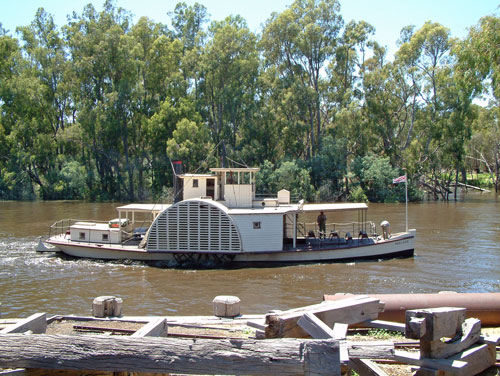
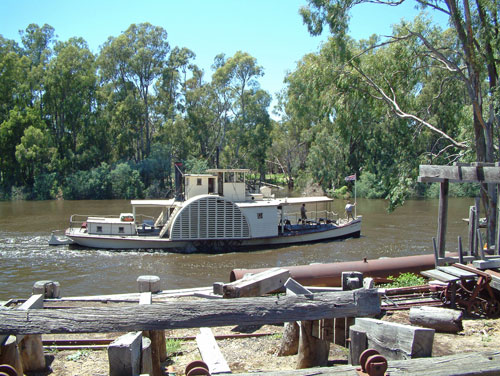
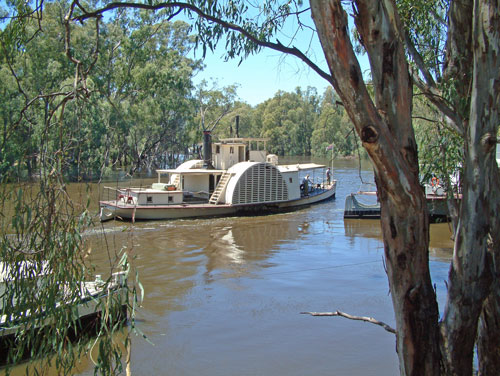
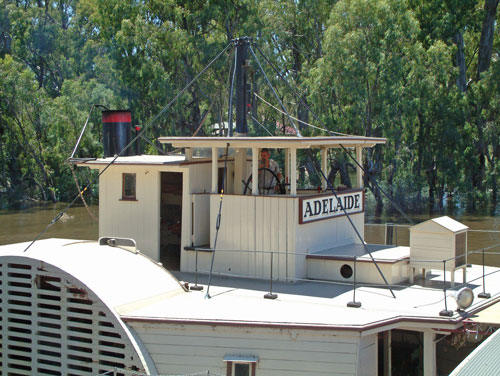
PS Adelaide of the Port
of Echuca Authority
Photos: ©2011 Ian Greig
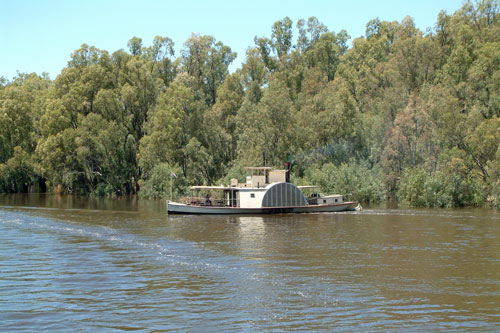
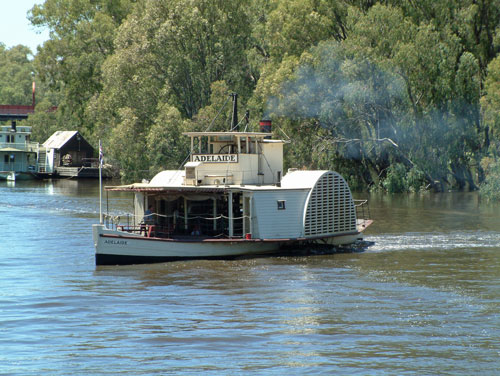
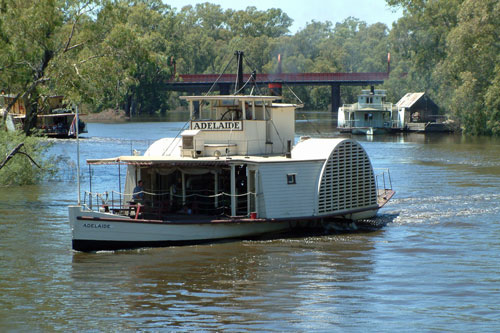
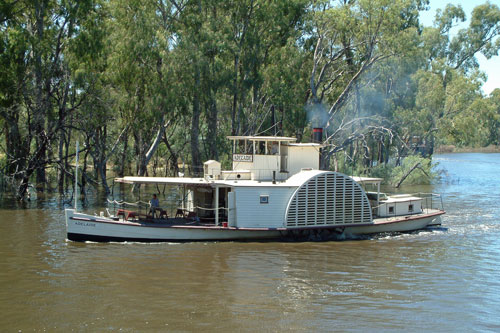
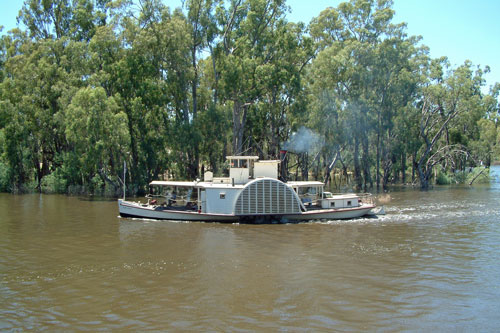
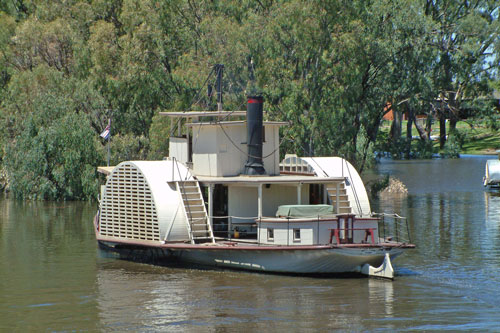
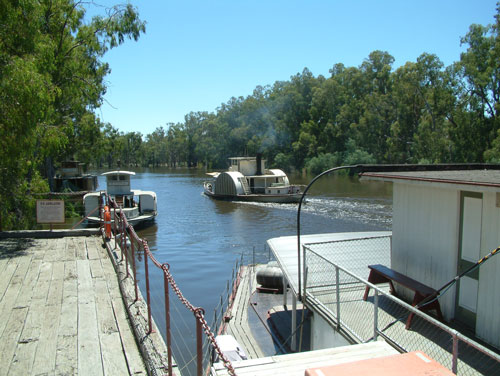
PS Adelaide (right),
Emmylou (left) and Hero (distance)
Photos: ©2011 Ian Greig
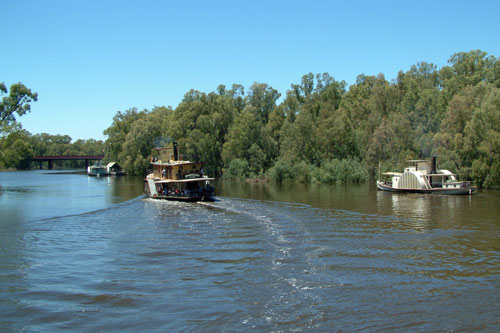
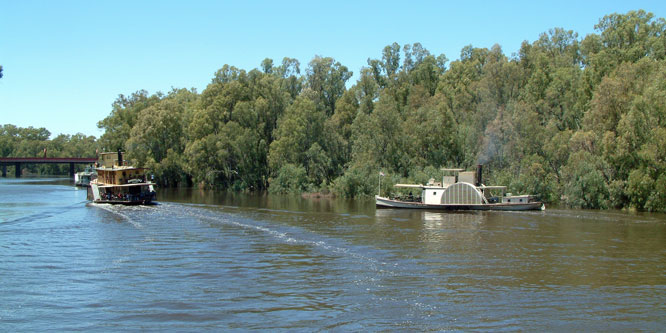
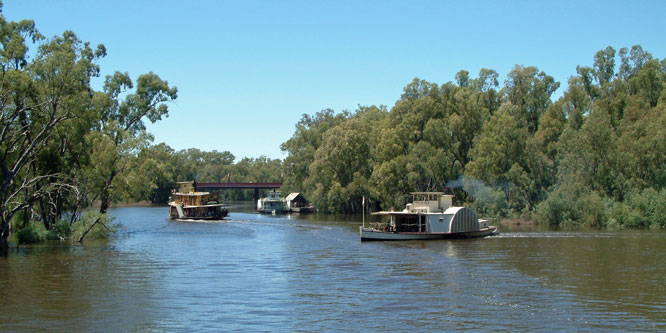
PS Adelaide of the Port
of Echuca Authority
Photos: ©2011 Ian Greig
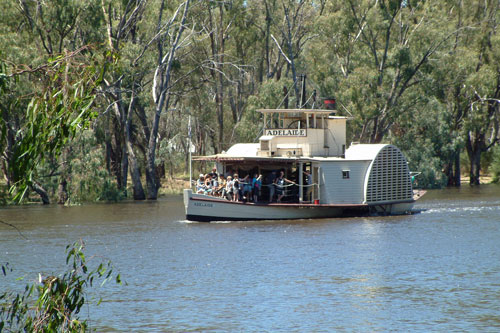
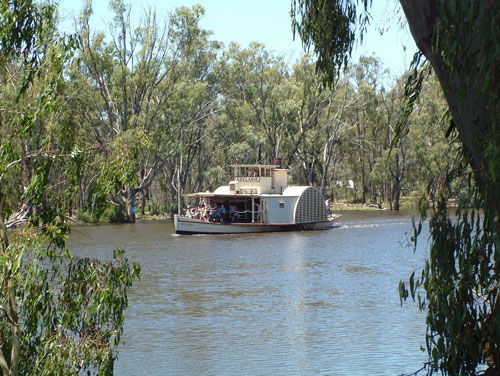
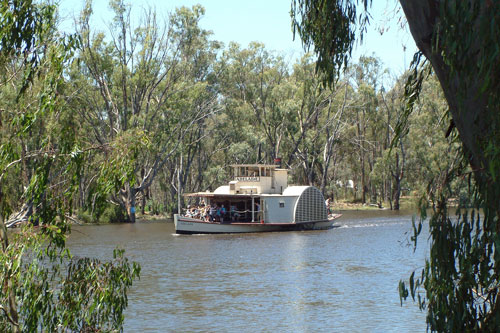
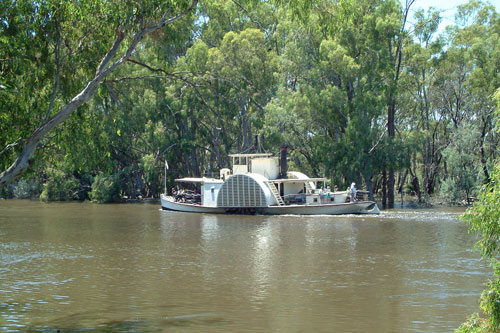
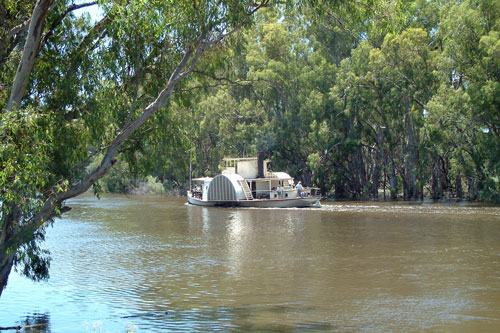
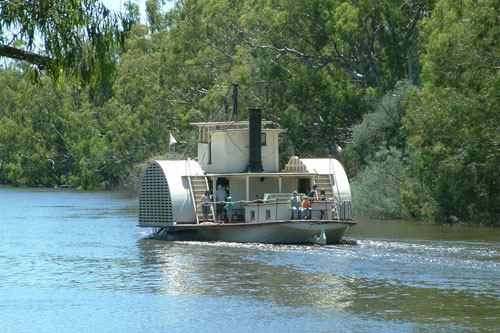
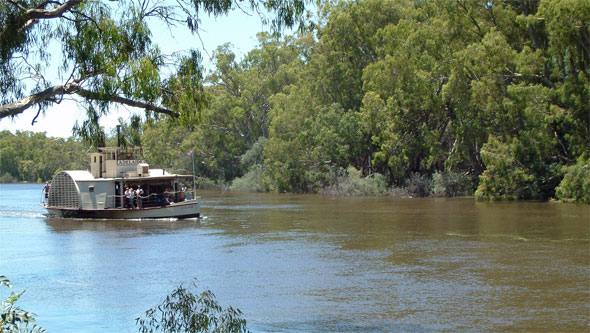
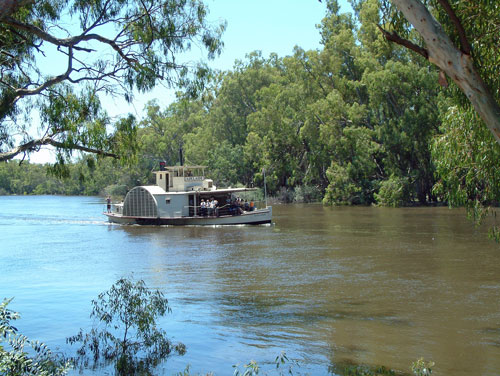
PS Adelaide of the Port
of Echuca Authority
Photos: ©2011 Ian Greig
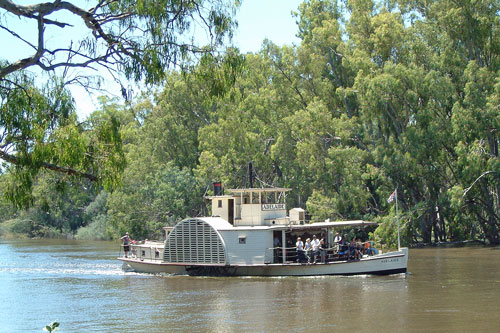
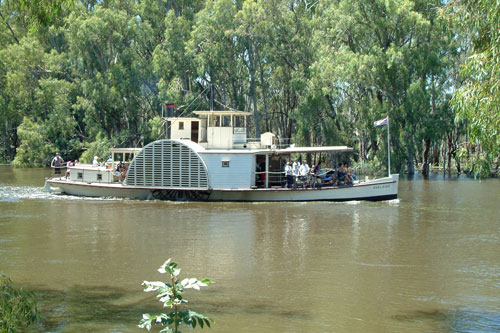
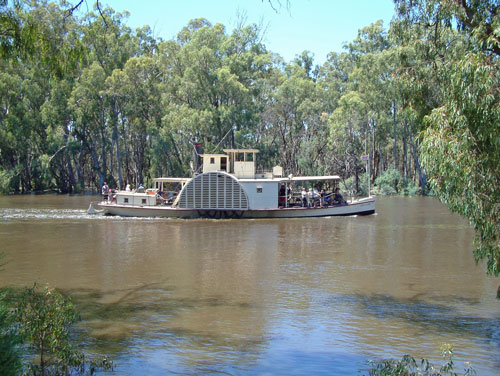
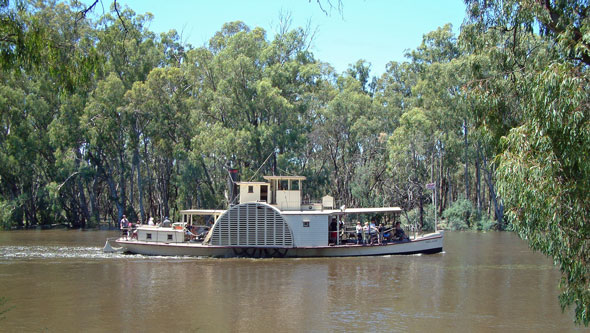
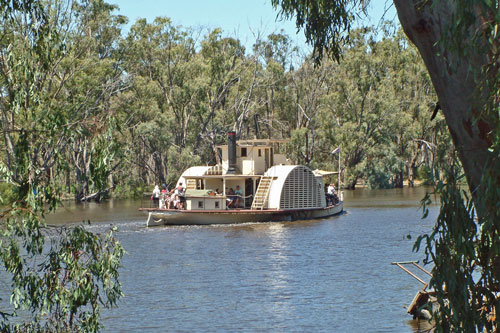
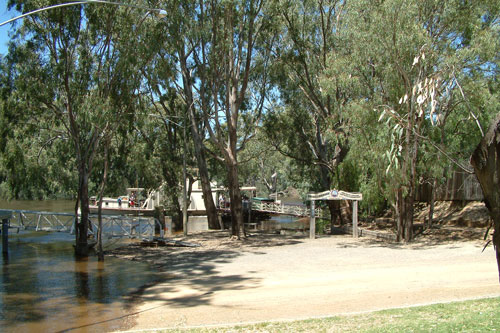
PS Adelaide of the Port
of Echuca Authority
Photos: ©2011 Ian Greig
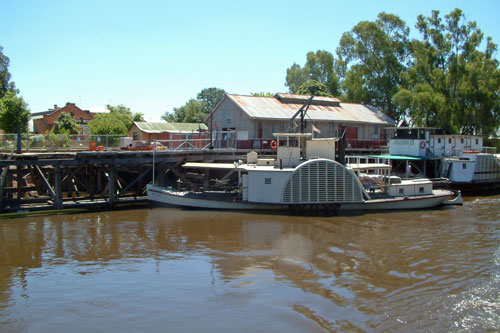
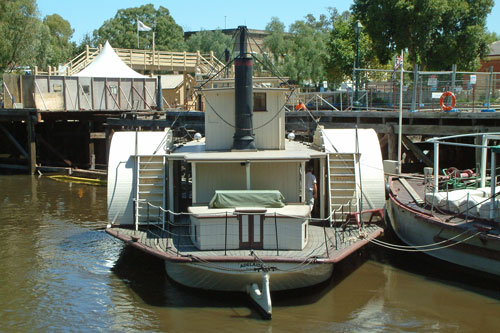
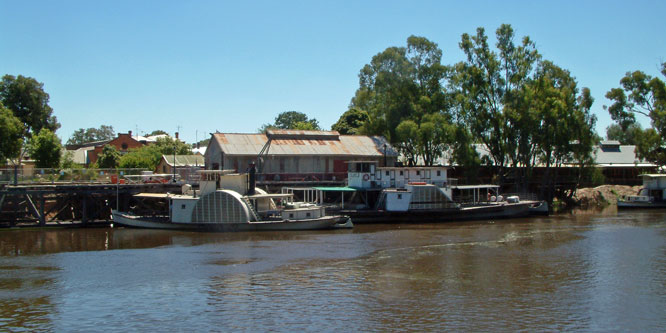
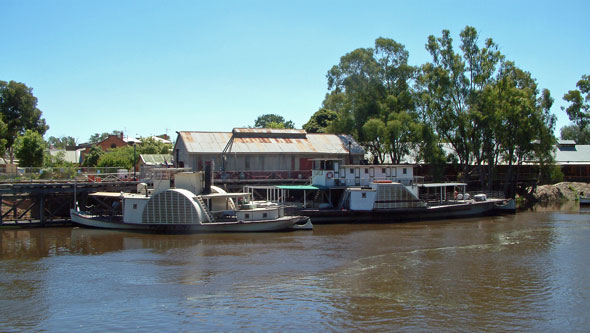
A trip on PS Adelaide of the Port
of Echuca Authority
Photos: ©2011 Ian Greig
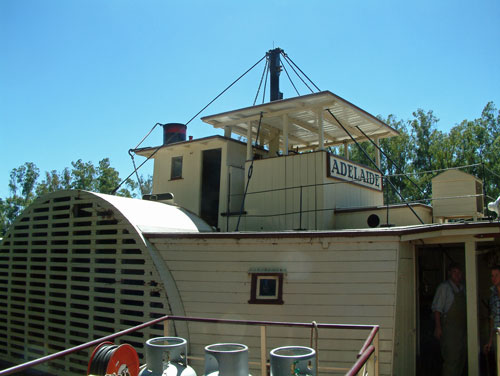
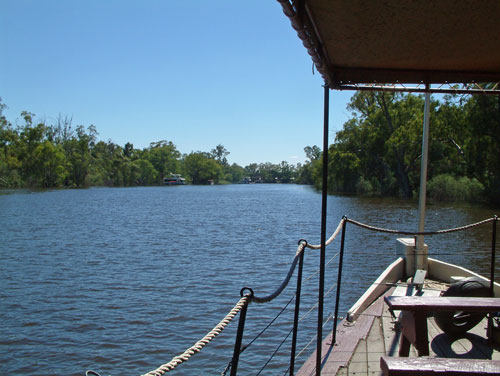
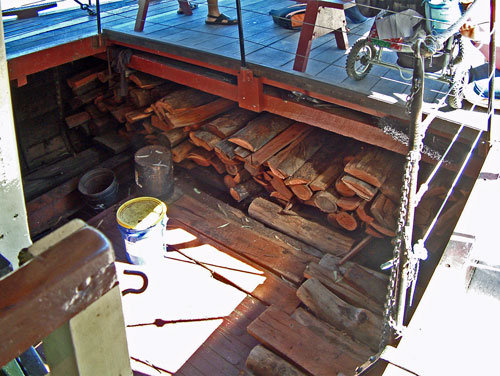
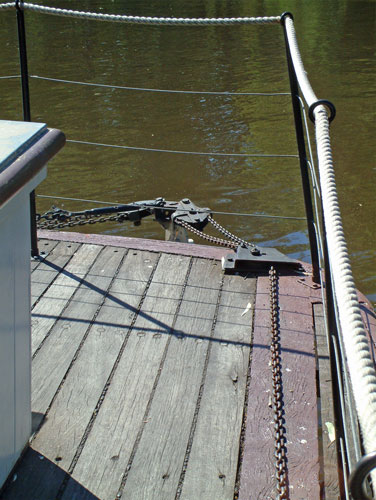
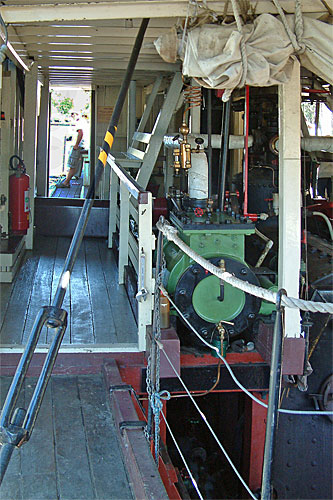
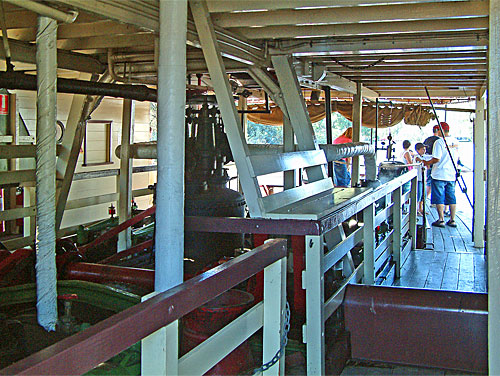
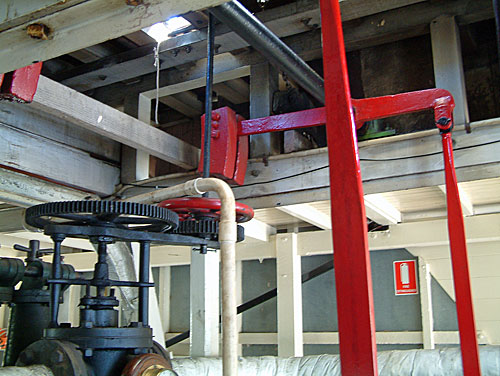
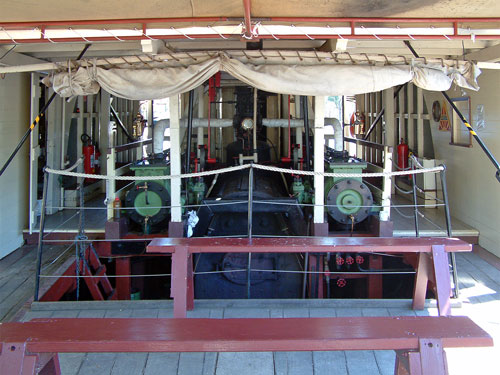
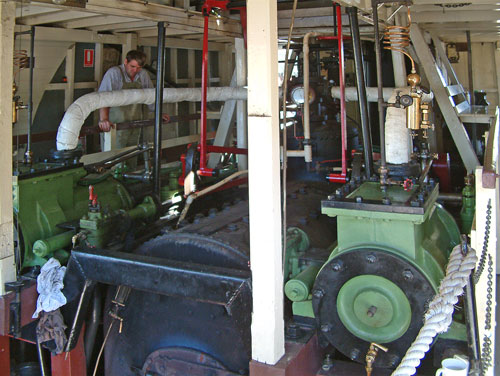
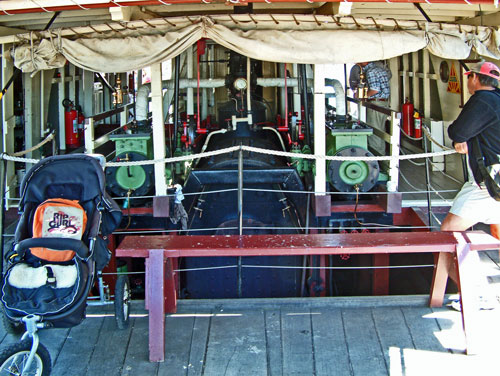
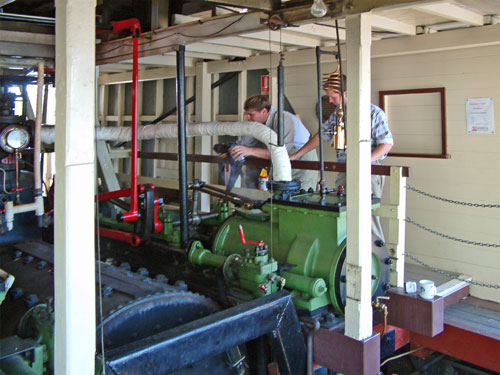
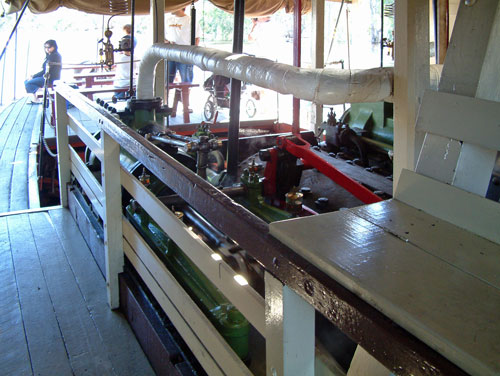
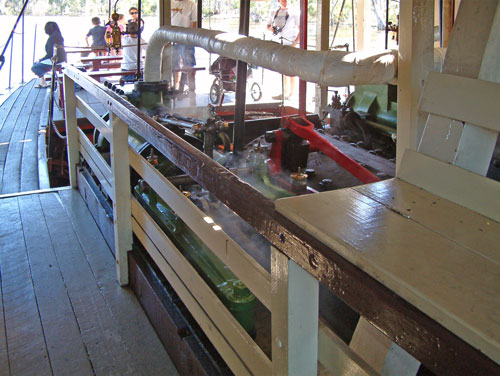
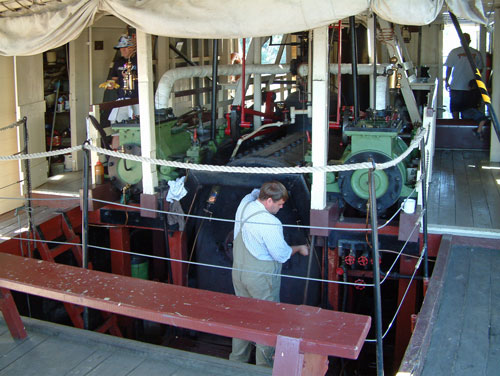
PS Alexander Arbuthnot
(1923)
Port of Echuca Authority
The Alexander Arbuthnot is named after the
owner of the sawmill at Koondrook for whom it was built. By 1947 it was out
of use, and had sunk. It was raised in 1972 and became part of a tourist
attraction at Shepparton. It was bought by the Port of Echuca in 1989 and
returned to active use.
Built: at Koondrook in 1923, the last paddle steamer
built for the commercial trade on the Murray
Tonnage: 46
Dimensions: length 76ft (22.8m); beam 15ft 3ins (4.6m);
draft 2ft 3in (0.7m)
Hull: iron frame, red gum planking
Engine: Ruston & Hornsby (England) 10hp, originally
used in an earlier vessel (Glimpse).
Speed: 6 mph (5.2 knots).
PS Alexander Arbuthnot of the Port
of Echuca Authority
Photos: ©2011 Ian Greig
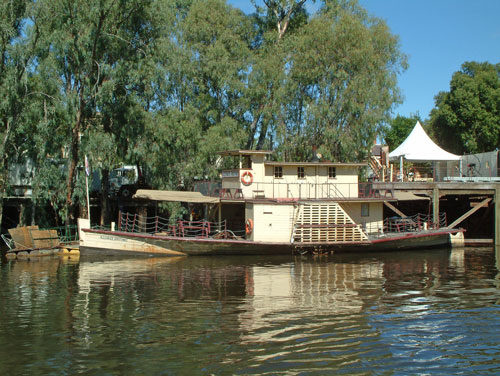
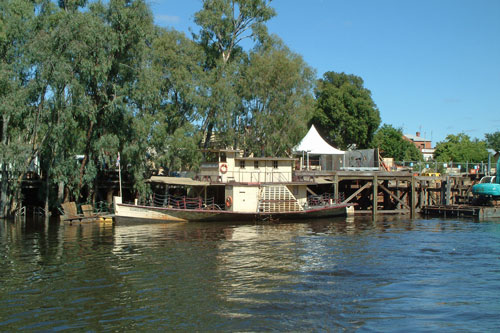
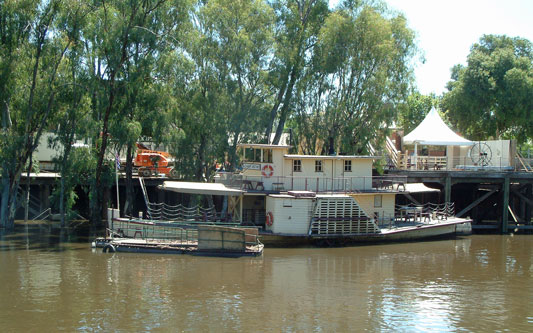
PS Pevensey
(1911)
Port of Echuca Authority
The PS Pevensey was originally built as a
barge in 1910, and was then converted into a paddlesteamer in 1911. She was
built in Moama for Permewan Wright and Company, one of the largest ship
owners on the river. Powered by a 20 hp twin high pressure steam engine, the
Pevensey is a large capacity cargo/tow boat and was capable of carrying 120
tons in giant holds. In 1932 she was almost destroyed by fire at Koraleigh
Landing below Nyah, but was rebuilt in 1933-35 at Morgan, South Australia.
In 1939 she ran a regular cargo run between Morgan and Mildura before
becoming redundant and being tied up at Mildura. In 1973 the Echuca City
Council purchased her from the Collins brothers and steamed her back to
Echuca. In 1975 she was slipped at Moama and completely restored. She now
operated from the Port of Echuca and was used in the mini series “All the
Rivers Run” playing the PS Philadelphia.
Tonnage: 130
Length: 111 feet 5 inches (33.42 metres)
Beam: 23 feet (6.9 metres)
Draft: 2 feet empty, 4 feet 6 inches when fully
loaded, this is approximately 0.6 metres when empty and 1.35 metres when
fully loaded.
Horse power: 20h.p.
Engine type: Built by Marshall & Sons of England.
It is a 2 cylinder steam engine No 55721.
Construction: Iron & timber
Fuel: Red gum logs.
Speed: 8 miles per hour, around 12 km per hour
PS Pevensey of the Port
of Echuca Authority
Photos: ©2011 Ian Greig
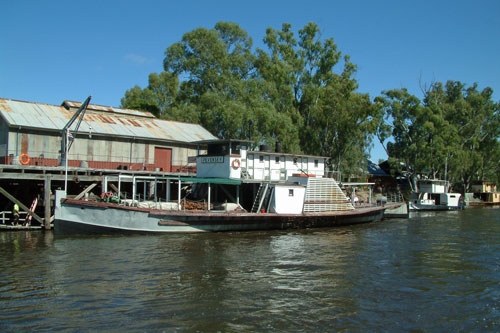
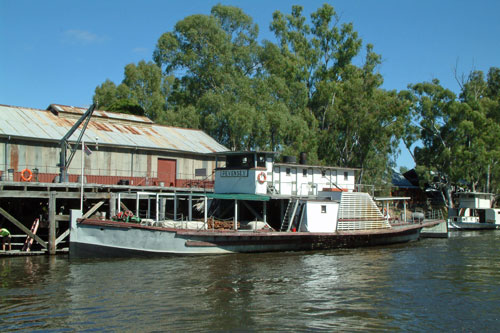
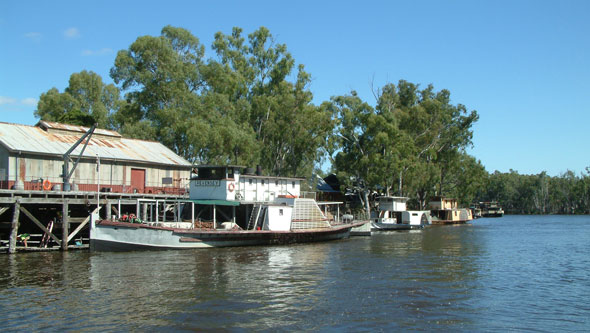
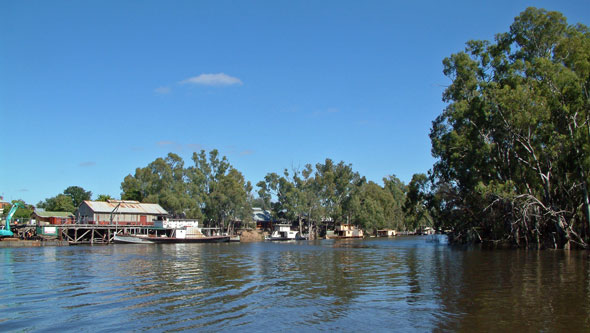
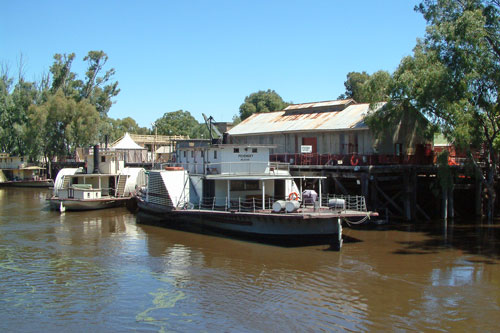
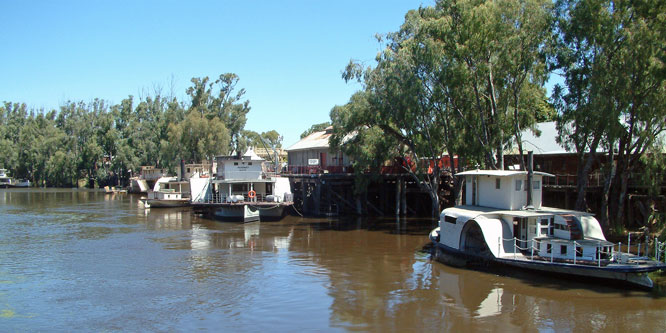
PS Pevensey of the Port
of Echuca Authority
Photos: ©2011 Ian Greig
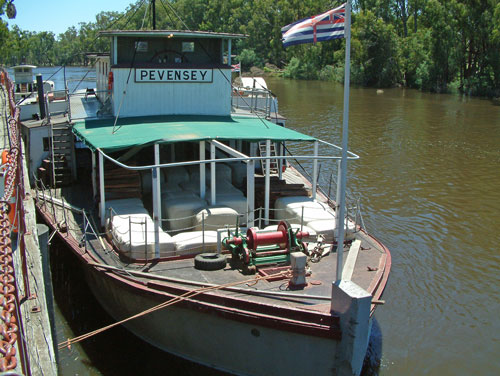
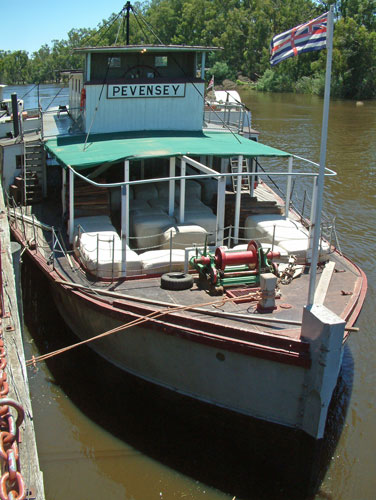
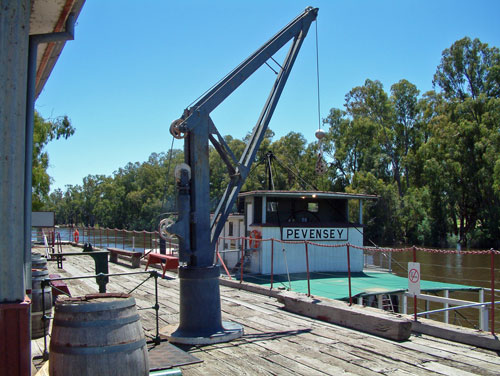
Murray River
Paddlesteamers Co.
After my second trip on
Adelaide I almost decided
not to bother with the other steamer operating, the Murray River
Paddlesteamer Co.'s PS Emmylou,
because although it is steam-powered it is actually a modern boat, built
locally between 1980 and 1982 specifically for the tourist market. I
thought, in an overly-purist way, that it was bound to be an anti-climax
after such a historic vessel as
Adelaide. Fortunately I came to my senses – travelling half way
round the world and not going on it for that reason would have been daft
even by my standards – and am very glad I did. It is a beautifully built and
maintained vessel. The hull form, paddleboxes and superstructure are in the
traditional style but with additional passenger and catering accommodation,
including overnight cabins for longer cruises. It is approximately 98ft
(30m) long and 33ft (10m) wide, with a steel hull and timber decking. The
engine is a 16hp 2-cylinder simple unit built in England by Marshall's of
Gainsborough in 1906, giving a top speed of about 10mph (8.6 knots). And
yes, it is named after the country-and-western singer Emmylou Harris, a
favourite of the owner.
As soon as we were properly under way on an open stretch of river, there was
an announcement over the tannoy inviting anyone who was interested to visit
the bridge. I waited until the initial rush had died down and then made my
way up, where I met the skipper, Peter Garfield. There is a man who knows
his paddle steamers. I explained I was a PSPS member from the UK, and he
immediately asked me what all the tragic news of the Lincoln Castle
was about. He was actually rather enjoying the high level of the river,
because it gave a better view over the river banks than is often the case. I
was on the bridge for most of the trip, enjoying the company and
conversation of Peter and one of his crew who joined us part way through. I
stayed in the background while we turned at the half-way point, when I was
able to watch the skipper controlling the engines from the bridge, as on the
Adelaide. I left the bridge as we approached the jetty at the end of the
trip, so that I was not a distraction for the serious work of coming
alongside.
The company's other steam vessel is the
PS Canberra. This was built
in South Australia in 1912 as a single-deck steamer for fishing. It was
later converted to carry cargo and in the 1940s was refitted as an excursion
boat with an added upper deck, operating at Mildura. It has been at Echuca
since 1963, and was restored in 2003 at which time the present 2-cylinder
Marshall compound engine was installed.
PS Emmylou
(1923)
Murray River Paddlesteamers
Emmylou is a beautifully built and
maintained modern vessel, built locally between 1980 and 1982. The hull
form, paddleboxes and superstructure are in the traditional style but with
additional passenger and catering accommodation, including overnight cabins
for longer cruises. It is approximately 98ft (30m) long and 33ft (10m) wide,
with a steel hull and timber decking. The engine is a 16hp 2-cylinder simple
unit built in England by Marshall's of Gainsborough in 1906, giving a top
speed of about 10mph (8.6 knots). And yes, it is named after the
country-and-western singer Emmylou Harris, a favourite of the owner.
PS Emmylou of Murray
River Paddlesteamers
Photos: ©2011 Ian Greig
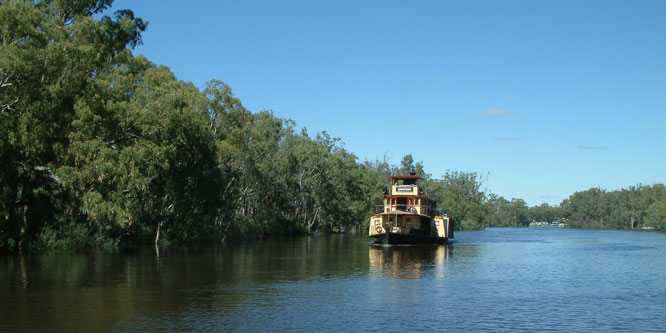
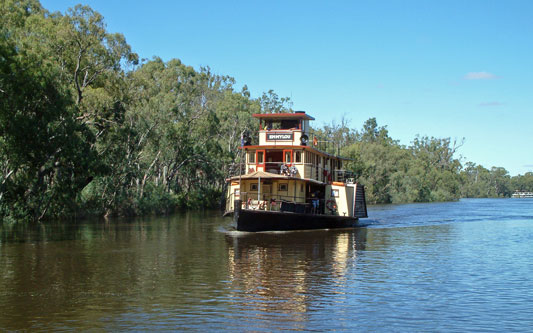
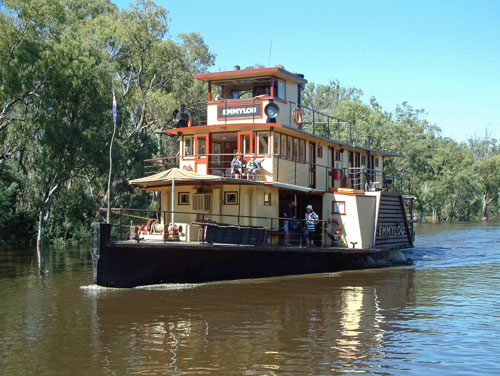
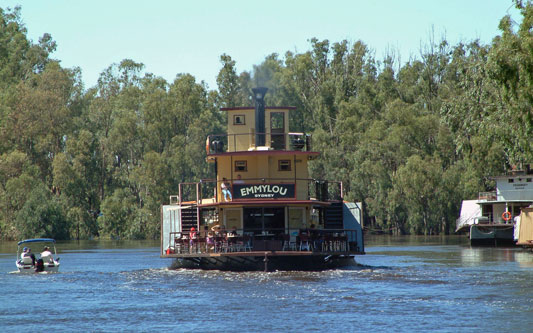
PS Emmylou of Murray
River Paddlesteamers
Photos: ©2011 Ian Greig
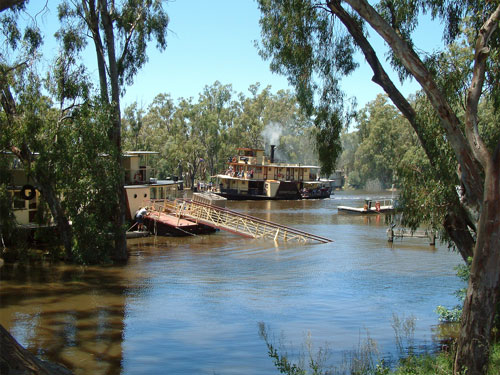
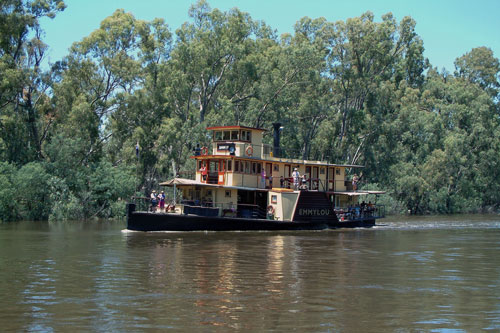
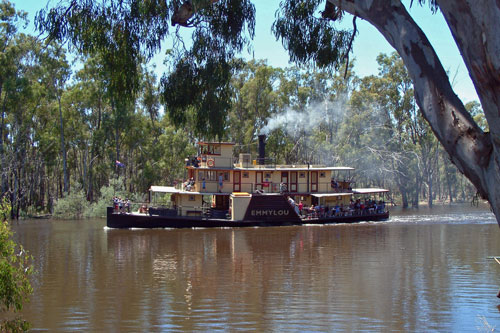
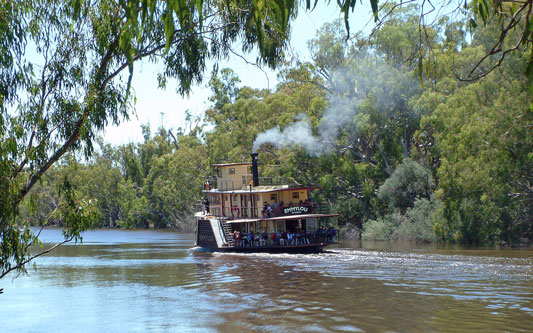
Emmylou (left), Adelaide (right), and Hero
(distance)
Photos: ©2011 Ian Greig



Emmylou of Murray River Paddlesteamers
Photos: ©2011 Ian Greig
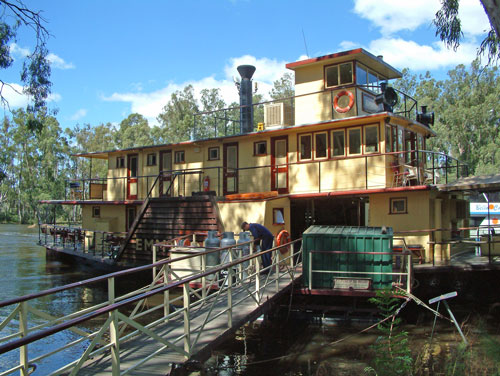
Engine room of
Emmylou - Murray River Paddlesteamers
Photos: ©2011 Ian Greig
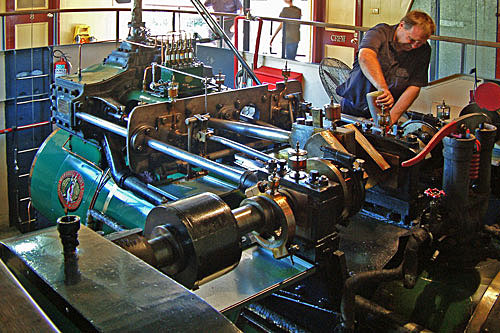
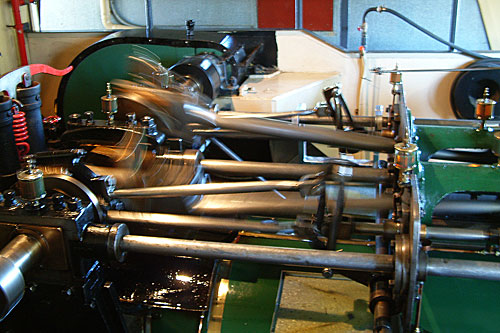
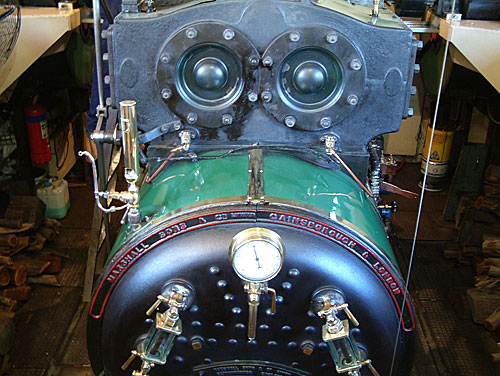
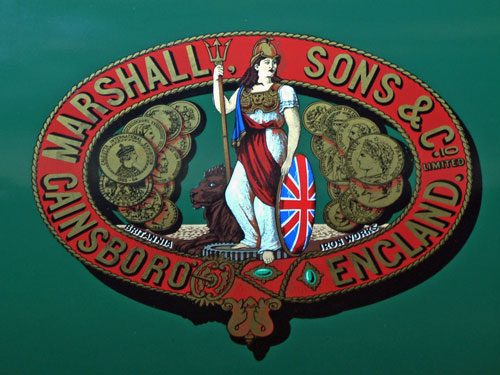
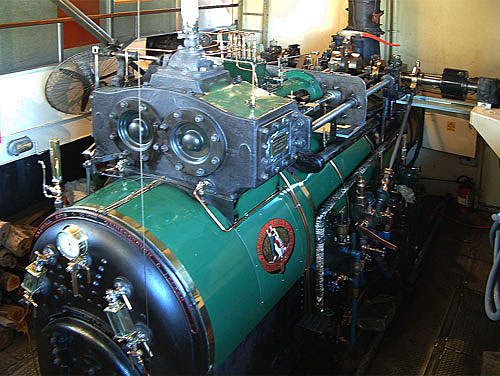
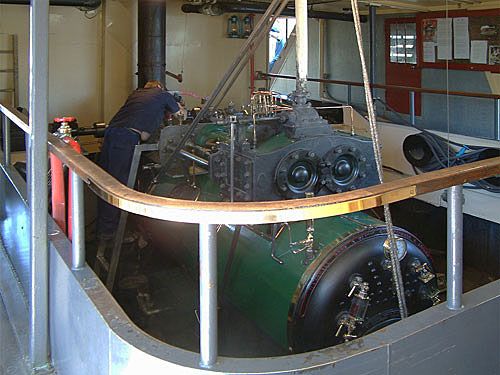
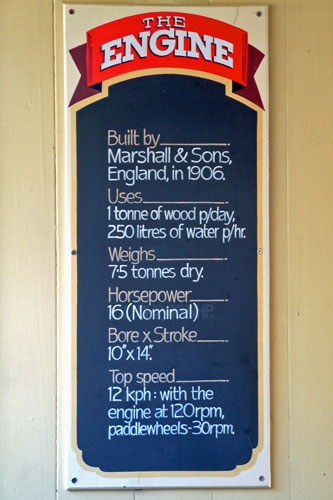
Wheelhouse of
Emmylou with skipper Peter Garfield
Photos: ©2011 Ian Greig
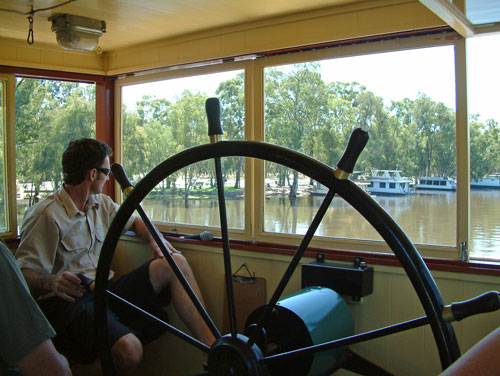
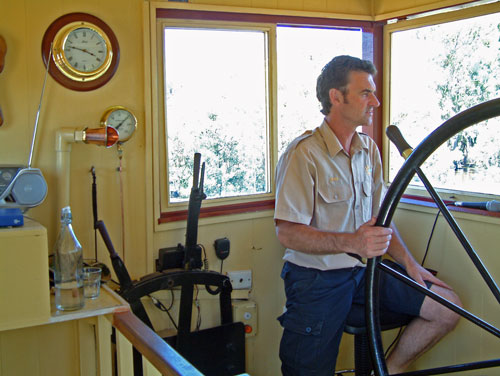
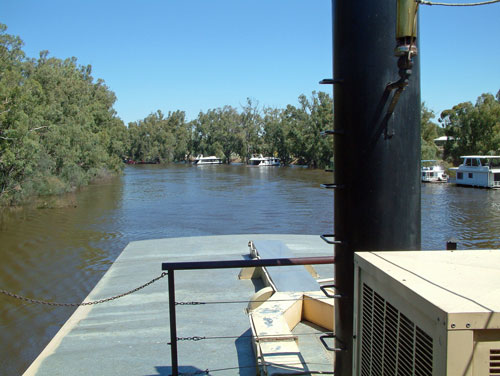
PS Canberra
(1923)
Murray River Paddlesteamers
Canberra was built in 1912, in Goolwa, South
Australia, downstream from Echuca on the River Murray. The paddle steamer
was restored in 2003. Canberra is powered by a 1923 wood-fired
Marshall compound steam engine.
PS Canberra of Murray
River Paddlesteamers
Photos: ©2011 Ian Greig
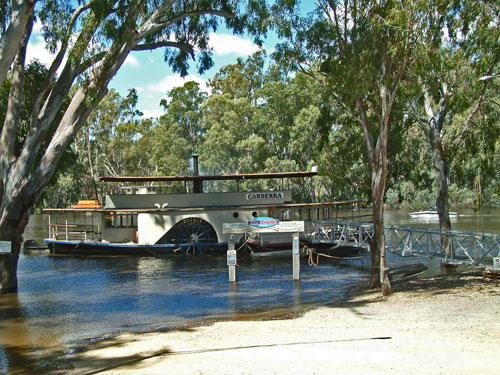
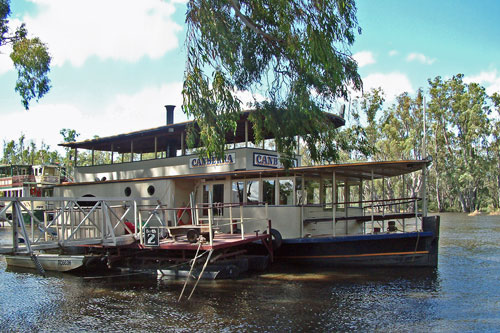
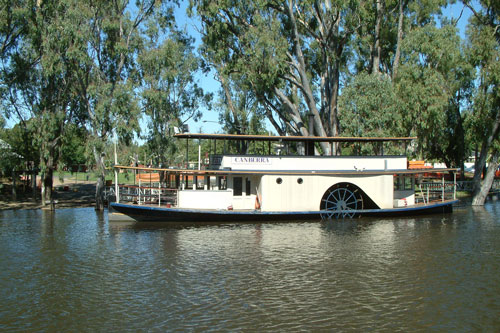
PV Pride of the Murray
(1924)
Murray River Paddlesteamers
The Pride
of the Murray was built as timber logging barge C24, at Echuca in 1924.
At the end of its working life it was abandoned and sunk in the River
Murray. In 1973 it was refloated and repaired at Moama slip, now using
diesel to power the paddles. The Pride of the Murray has dimensions
25.1m x 4.9m x 1.5m. Its paddle-wheels came from the PS Hero.
Diesel paddler Pride of the
Murray of Murray River Paddlesteamers
Photos: ©2011 Ian Greig
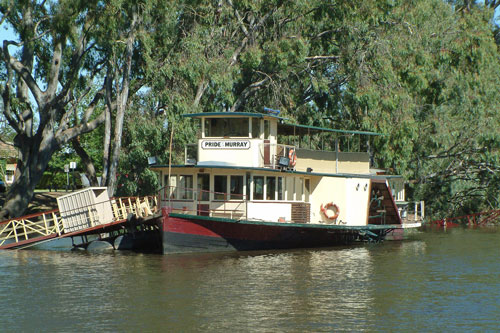
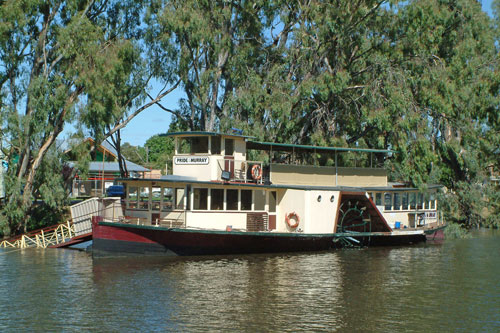
Diesel paddler Pride of the
Murray of Murray River Paddlesteamers
Photos: ©
www.emmylou.com.au
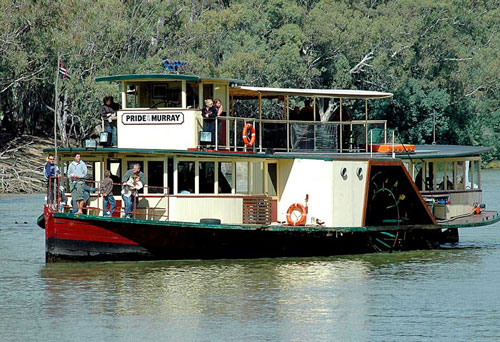
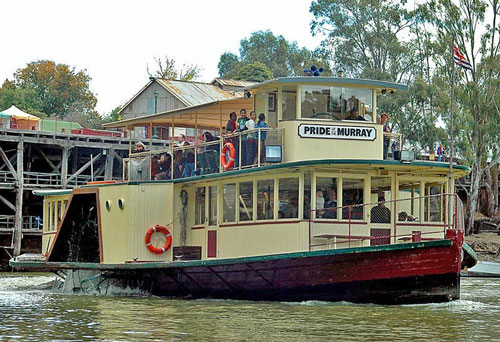
Independent
Paddle Vessels
There are a number of other privately owned paddle
steamers at Echuca. PS Etona
was built in 1898 as a Church of England missionary steamer with the aid of
funding from Eton College (hence the name and the cross over the bridge).
Made redundant when churches were built in the river towns, it became a
fishing vessel in 1912. It was later bought and moved to Echuca, where
restoration commenced in 1962. It still has its original engines. In theory,
PS Hero is one of the oldest
survivors, originally built in 1874 by the builders of
PS Adelaide, Linklater's of
Echuca. However, not much of it is original. It sank in 1957 when it caught
fire after being left with the engines still hot after being used to rescue
cattle from flooding. The hull with the engine was raised in 1998. After
extensive repairs, it has been rebuilt with replica engines and totally new
superstructure aimed at the luxury charter market. The 2010 draft Murray
Shire Mooring Plan (available on line at
www.murray.nsw.gov.au) lists these other historic paddle steamers as
being based at Echuca: PS
Perricoota, PS Henry Charles, PS Ranger, PS James Maiden, plus a
modern vessel, PS Britannia and a new one under construction,
PS Adventurous; most of these are moored where they can be easily seen.
PS Billy T (ex-Billy Tea)
PS Billy Tea was built by Luke Roberts in
his backyard in Canberra. Its steel hull is 47ft long and 1oft wide,
. Luke also built the boiler and the single cylinder steam engine. It was
launched at Yarrawonga in 2003 and sailed to Echuca. Sold in 2008 and 2011,
new owners Bob & Judi McGrath renamed it Billy T in 2014.
Private steamer PS
Billy Tea (now Billy T) alongside Britannia
Photos: ©2011 Ian Greig
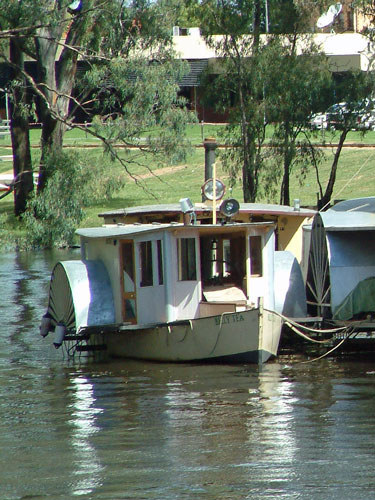
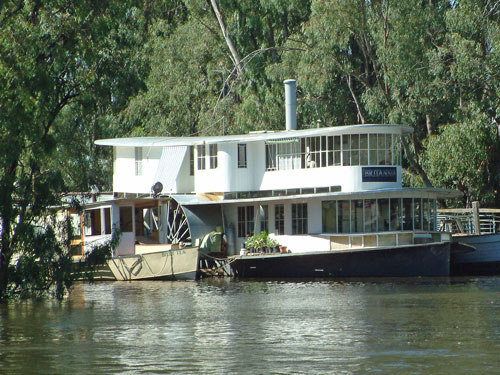
PS Britannia is the fifth paddleboat built
by Peter Macleod and was assembled in a field near Echuca Village. It was
launched into the Murray River in 2003 for completion of the upperworks.
Britannia is fitted with a restored 12hp Marshall steam engine built in
1913 and also has a diesel engine. It is privately owned.
Private steamer PS
Britannia
Photos: ©2011 Ian Greig
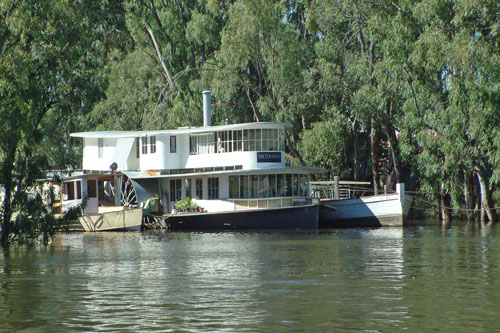
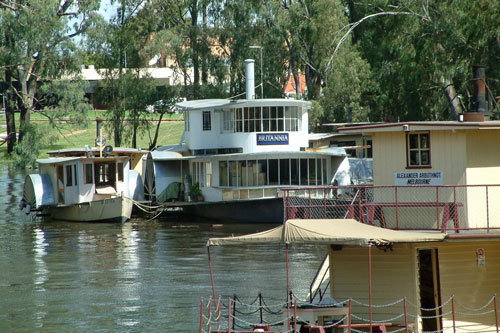
PS Etona was built in 1898 at Milang, South
Australia as a missionary church steamer for the Church of England. The
Etona’s run was from Mannum, South Australia, where she was based, up
to Renmark. As churches were built in river towns she was no longer required
and in 1912 she was sold to Captain Arch Conner who used her as a fishing
steamer at Boundary Bend for many years. She was bought out of retirement
during the 1956 floods to do trips up the Murrumbidgee River. She was
eventually bought by interests in Echuca and restoration was commenced in
1962. The Etona, now fully restored with her original steam engine
can now be seen moored alongside the historic wharf at Echuca.
This paddlesteamer is the second missionary vessel with the same name of
Etona. The first Etona was a propeller driven steam launch
previously owned by the South Australian Police Force and named
Patroller. It saw service as a police launch at Port Adelaide, South
Australia. The Murray River Mission Boat fund was set up by the Church of
England (Australia) and funds were raised for the launch to be bought for
about 110 pounds ($220). The boat was transported to Goolwa by rail, and new
fittings, cabins, alterations and repairs raised the initial cost to 188
pounds ($376). The steam launch was named Etona on 12th June 1891.
By 1897 it was showing the effects of six years of hard work and eventually
the mission decided to sell the vessel. The old Etona was re-named
Alma.
Missionary steamer PS Etona
- note the cross
Photos: ©2011 Ian Greig
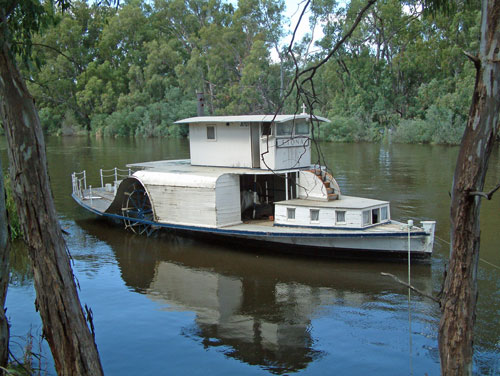
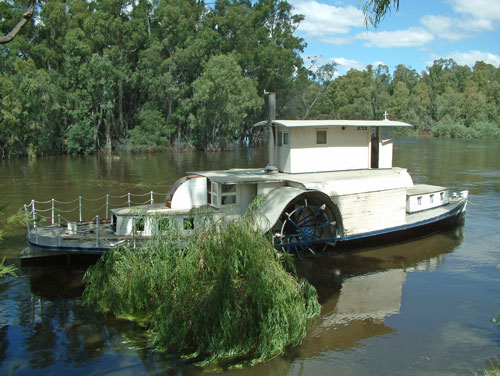
Missionary steamer PS Etona
- note the cross
Photos: ©2011 Ian Greig
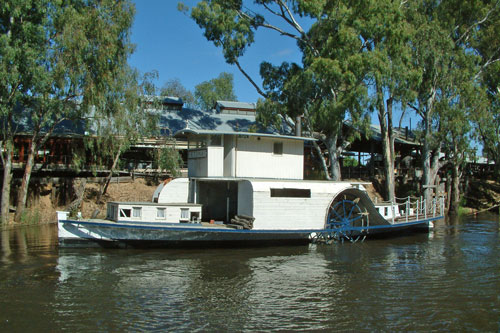
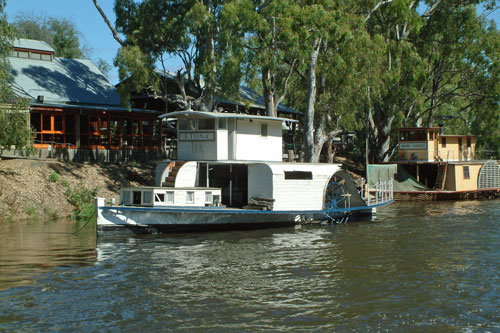
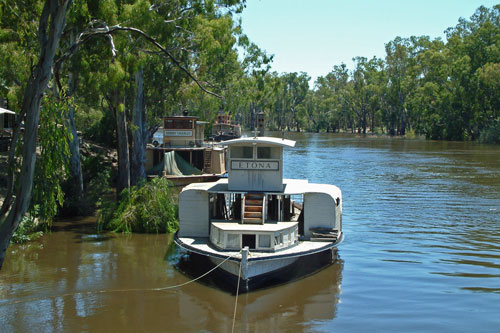
PS Henry Charles is a private boat - the
last paddlesteamer to be completed in the 20th century. It was built in
Wyuna, near Echuca, by Russell and Jarrod Beer. It is 20m long and power is
provided by 10hp Ruston Proctor portable steam engine.
Private steamer PS
Henry Charles
Photos: ©2011 Ian Greig
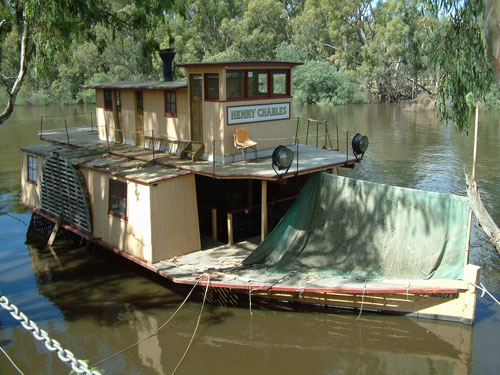
In
theory, PS Hero is one of the oldest survivors, originally built in
1874 by the builders of PS
Adelaide, Linklater's of Echuca. However, not much of it is
original. It sank in 1957 when it caught fire after being left with the
engines still hot after being used to rescue cattle from flooding. The hull
with the engine was raised in 1998. After extensive repairs, it has been
rebuilt with replica engines and totally new superstructure aimed at the
luxury charter market.
Private steamer PS Hero
Photos: ©2011 Ian Greig
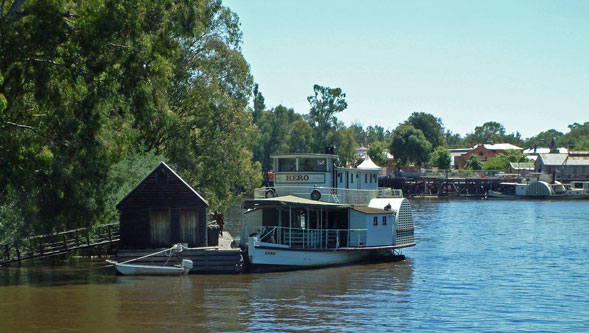
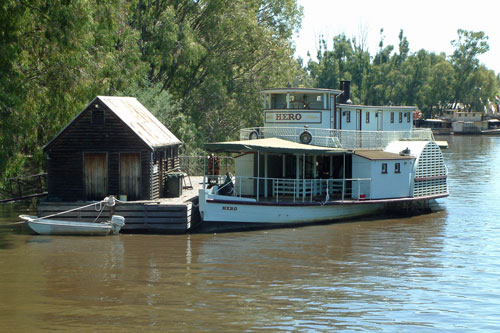
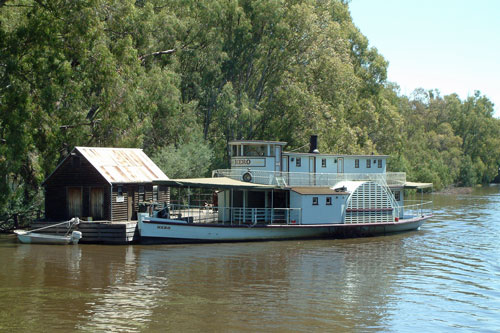
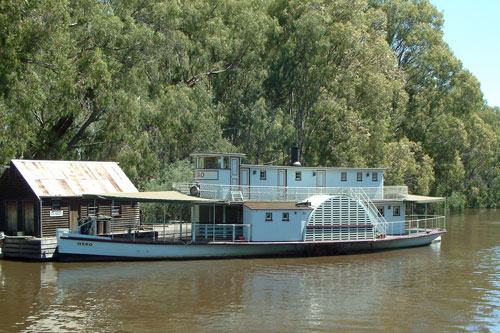
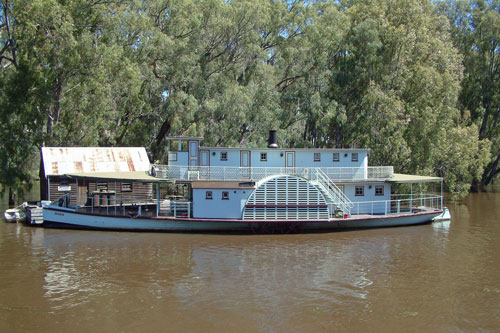
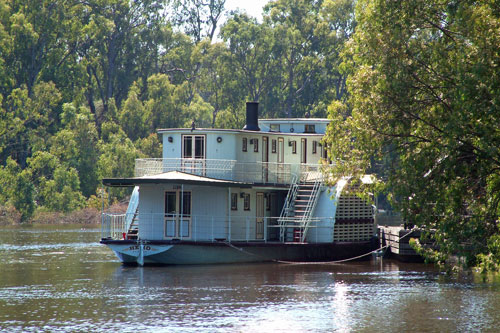
PS Perricoota is a private boat built 1999,
originally
with a Brown & May engine 6hp steam engine dating from 1909. This has since
been replaced by an 8hp Marshall.
Private steamer PS
Perricoota
Photos: ©2011 Ian Greig
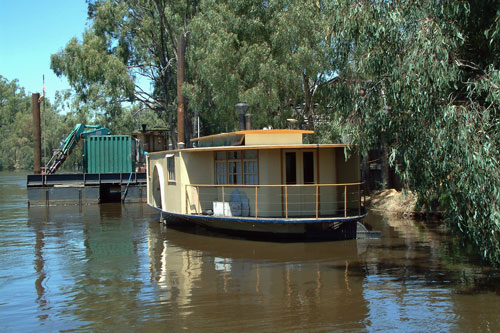
Books on Australian Paddlesteamers
A selection of recommended books on Australian paddle
steamers
Paddlesteamers and Riverboats of the River Murray
Author: Peter Christopher
Publisher: Axiom Publishing 2000 (Revised and
enlarged 2001)
This 2001 book is described as a helpful guide to the
most significant boats that were running on the River Murray. It covers 50
boats all illustrated in colour, with technical details and short histories.
The book is A2 format and the photos are rather small and not reproduced
particularly well. Whilst available very cheaply from used bookshops this is
not particularly recommended compared to Peter Christopher's later book
shown below.
Australian Riverboats - A Pictorial History
Author: Peter Christopher
Publisher: Axiom Publishing 2007 (Revised and
reprinted 2008)
This 2007 book by the author of the book is a far
more lavish production. Unlike the other books here which are primarily
guides to their contemporary fleets, this on covers the history of the boats
from the first Murray steamboats in 1852 articles, fleetlists and many large
format monochrome illustrations. A chapter at the end shows 20 significant
surviving boats with old and contemporary colour photos. There is an
index of over 150 boats illustrated but it is page number order - not a lot
of use in finding a specific boat. This is a beautifully produced book with
lots of lovely illustrations but tends somewhat towards the 'coffee-table'
market.
Murray Darling Paddleboats
Author: Peter Plowman
Publisher: Rosenberg 2005
Peter Plowman has written numerous definitive books
on Australian shipping, all well produced and illustrated. This book is a
guide to all the Murray & Darling paddleboats both old and new, each
illustrated with wonderful colour photos all taken (bar one!) by the author
who has made regular trips to the area for many years. About 100 boats are
described and illustrated. However the number of new boats being built or
restored each year means that it is quite out of date now. The definitive
guide is the enlarged book shown below.
Paddleboats of Australia
Author: Peter Plowman
Publisher: Rosenberg 2014
This is an updated and expanded guide to existing
riverboats both operational and in static retirement throughout Australia.
About 150 boats are described and illustrated. None of the illustrations
appear to have been carried over from the previous book which is most
commendable. A gorgeous book whether for reference or just browsing.